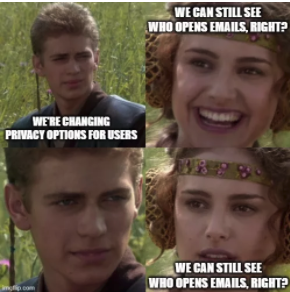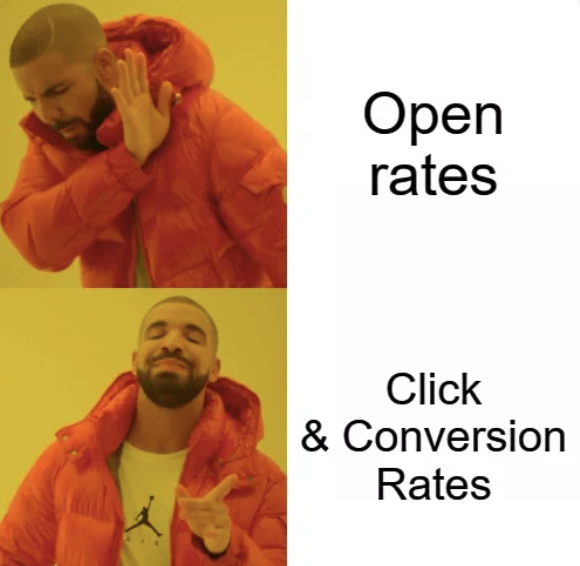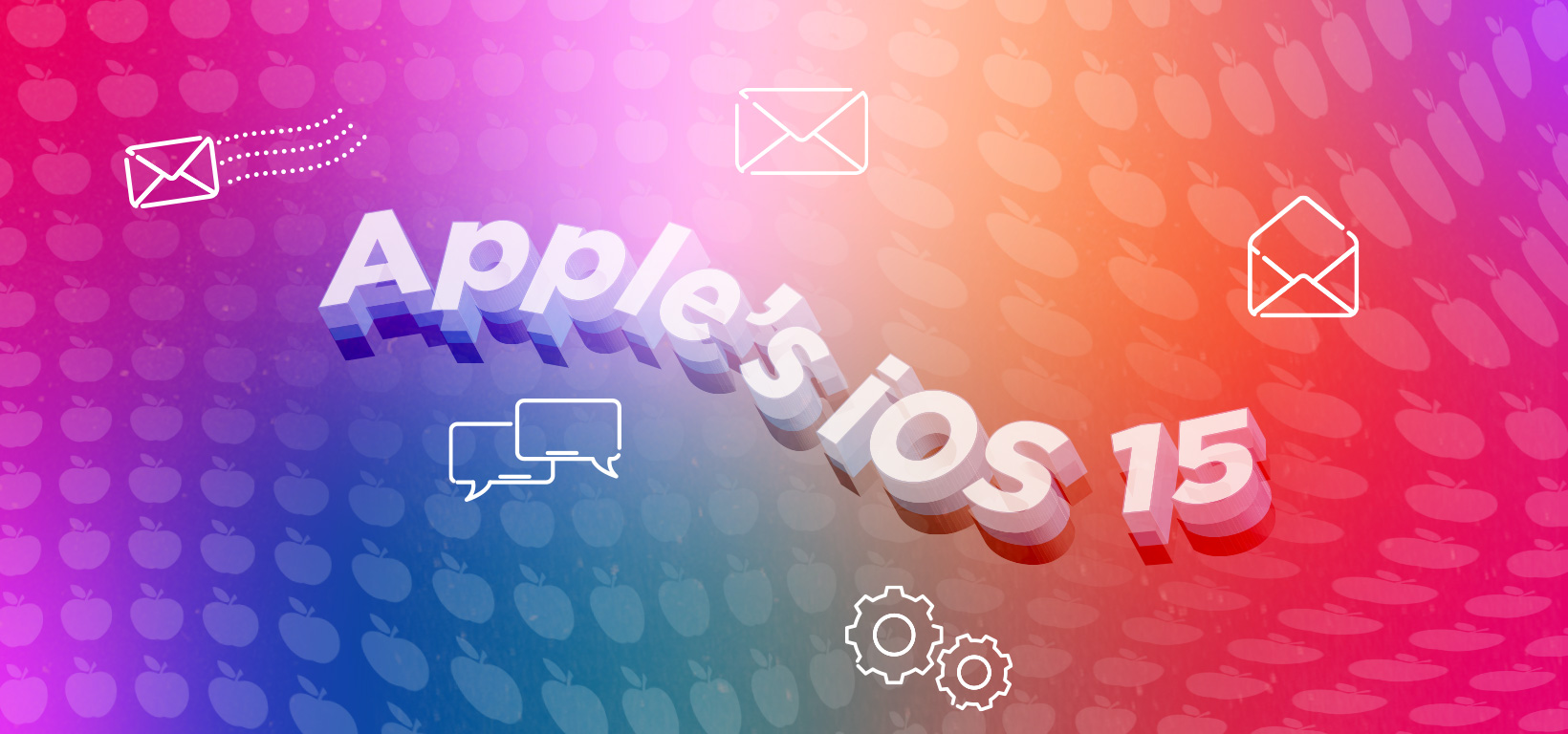For what seems like years and years (and yep, you guessed it—years), open rates have been invaluable to email marketers—a cozy, secure, reliable source of knowledge. However, Apple has started demolition on that source, and flipped a long-standing asset of email marketers into kryptonite. The days of smoothly acquired user-information with room for extreme personalization via open rates are slowly fading in the rearview mirror. But Superman never gave up, so neither will we.
First, let’s get you caught up on what ~the heck~ is going on with this whole iOS 15 update, then we’ll give you some practical takeaways to prepare for the storm.
During Apple’s Worldwide Developers Conference in June, the tech giant reported the unfurling of a few new privacy features offered with iOS 15. While the anticipated iOS 15 features are sure to delight many users, they put email marketers into a challenging position. Throughout the next couple of minutes, we’ll be taking a look at the following ground-shifting features:
- Mail Privacy Protection
- Cloud +
- Hide My Email (within Cloud+)
Mail Privacy Protection (MPP): This free feature will offer iOS 15, and macOS Monterey Apple Mail, email users the option to privately preload remote content and images in emails (as opposed to loading at the time of open). This will cause the email to report an open, even though it wasn’t actually opened by the recipient, and will block the sender’s ability to accurately track opens and open rates for recipients who are using this feature. Essentially, if your entire audience was using this feature, it would appear that every email you send is receiving a 100% open rate.
This is the most controversial feature of Apple’s privacy update and will certainly shift the metrics that we discuss and utilize daily. No longer will you be able to accurately define your list of “engaged” subscribers based on Opens. No longer will you be able to run accurate Subject Line A/B tests based on Open Rate. Marketers will now be blind to email opens for those users who have chosen to utilize MPP. Unless ISPs are able to define another method to track valid opens, this metric will soon be a thing of the past.

In addition, the MPP feature will mask the recipient’s IP address and only show a general location. In recent beta tests with MPP enabled, testers are showing a large discrepancy in the location returned from any reported opens. For example, some tests had the users open an email in North Carolina, but the returned location was Atlanta.
It is important to note that the MPP feature will not be enabled by default; users will have to implement these preferences on their own account if they desire it. Apple will likely build in a few prompts to help users make this shift and explain the feature, but it is not done automatically. However, as of early 2021, Apple holds 38.9% of the Email client market share (having increased almost 5% since last year).
Contrastingly, recipients that utilize the GMail app, Outlook, and/or Android devices will still remain trackable, unless Android hops on the email privacy train. Should Android capitalize on this, almost 98% of smartphone users will have the choice to increase their privacy, quite literally, at the tip of their fingers.
Email content will no longer be loaded at open-time within Apple and iOS Mail, as a result of the updates emerging in September. This means whether or not you’re prepared, the email marketing industry is changing at a rapid speed, and it’s either sink or swim. As the future unfolds, the following email marketing strategies actions will be supreme in how the industry creates content strategies, no more of the vanity metrics:
- Utilizing deeper-impact metrics such as conversion rate, revenue per subscriber, or increased LTV
- Getting to know subscribers better by utilizing first-party profile data
- Create actionable content that drives engagement in order to better understand user-intent
- Taking time to seek out new subscribers who actively engage with brands rather than just getting absolutely anyone to sign up
- Regular list cleaning to remove users who fail to add any value to the email program
- Building a trustworthy channel so that emails stay in the inbox unlike organizations who don’t focus on the reader’s interests and are perceived as “spammy”
iCloud+: What we have here is basically an enhanced, boosted version of the beloved cloud service, iCloud. iCloud+ allows users (who pay extra for the subscription) to benefit from additional privacy features like Private Relay, and an upgraded Hide My Email.
Let’s Take a Look at These iCloud+ Features:
- Private Relay: Users’ online browsing in Safari, DNS resolution requests, and insecure http app traffic is protected by Private Relay. Internet connections set up through Private Relay employ anonymous IP addresses that correspond to the region a user is in, rather than revealing the user’s precise location or identity. There’s nothing further to do—not a single thing to install or set up. The Private Relay feature essentially keeps users’ profiles as consumers virtually incognito.
- Hide My Email: Available on iOS 15, macOS Monterey, and iCloud settings, this is an upgraded version of Sign in with Apple which debuted in iOS 13. It’s an email address-cloaking feature that enables users to sign up for email offers, app or website accounts, website purchases (essentially any field where Apple recognizes you’re being asked for an email address) with an Apple-generated randomized address instead of their real email address. These randomized, one-time-use emails will be forwarded into the user’s main email account, allowing users to delete this fake email address easily, and prevent its spread across the web. Emails sent from the brand to the generated address will still land in someone’s inbox, but brands will not be able to see the person’s real address unless the contact chooses to share it.
So, What’s Different?
Apple is expanding this feature beyond merely signing up for apps and services, allowing users to generate these addresses whenever and wherever they choose. Additionally, the addresses are considerably nicer, ending in “@icloud.com” instead of the more onerous “@privaterelay.appleid.com” domain used in the previous version. iOS 15 email marketing update allows users to handle every address they’ve added via Sign in with Apple during the last two years.
What Does This Mean for Marketers?
- No simple way to tell if a new email sign-up is a legitimate account
- Potential for deliverability issues for brands as subscribers can quickly delete their email
- Increased bounces + concerns to ISPs alter its deliverability (Although reputable email service providers, on the other hand, eliminate “hard” bounces automatically, removing their impact on ISPs)
All in all, this implies that every company, big or small, will have to work harder and harder to develop genuine, trusted relationships with their customers, winning the right to learn who they are and what they care about, instead of acquiring it automatically.

What’s true about today’s consumers is that they desire privacy AND customization at the same time.
Subscribers still want personalized messaging and content that resonates with their passions, but not at the detriment of their privacy. It is a delicate balance, and because of Apple’s adjustments, email marketers will now have to focus even greater efforts on producing exceptionally relevant content that motivates their users to take action, rather than experimenting with headlines to see if they can generate a click. The good news is that personalization isn’t going anywhere and conversion optimization isn’t going anywhere. However, each of these will need extra effort put into developing deeper relationships and taking more impactful actions.
So, how do we, as email marketers, gear up for this shift in user privacy compliance? First, building trusting relationships with our audiences is paramount–there cannot be anything more important than this detail. Practice makes perfect, and there’s no difference when it comes to deliverability habits. If not doing so already, focus on these email marketing strategies:
- Maintain a good domain reputation – This includes IP address and sending domain consistency. Ask these questions: Are your messages being delivered? Is your IP address legitimate? One way to track your domain reputation is to set up a Google Postmaster account to see how Gmail is rating and processing your emails.
- Full email authentication – Email authentication provides assurance to mailbox providers (such as Gmail or Outlook) that the content they receive from senders is genuine and not delivered by a fraudulent actor. The more trust a mailbox provider has in the emails you send, the more probable it is that the message will be delivered to the inbox successfully. You can do this by talking with your ESP or CRM provider and ensuring you have implemented a sender policy framework (aka SPF)
- Utilize active opt-in permissioning – Subscriber consent must be given freely, it must be specific, it must be informed, and it must include some sort of signified agreement. Give users an obvious choice to opt-in or opt-out in each message sent, not only when their information was first collected. This may mean enlarging the print where these options are available, maintaining that honest and upfront reputation. We recommend you utilize a double opt-in to defend against spam complaints. Simply send a confirmation email to the new subscriber requesting that they confirm their address and consent.
- Prompt removal of opt-outs and unknown users – Schedule a periodic suppression of inactive or disengaged subscribers, so as to continue achieving optimized subscriber performance.
- Check feedback loops (FBLs) – Collect and respond to data from recipients who have complained about the sender’s email (aka Complaint Feedback Loops), so as not to flood those users with unwanted messages, and thus, decreasing spam complaints.
While Apple’s changes seem world-ending at first glance, they’re not as detrimental as you might think.
It’s important to understand the desire for more mail privacy protection, and react in a way that respects your consumers and their preferences. Companies, now more than ever, need to be focused on harnessing first-party and zero-party data. In fact, 79 percent of customers are willing to share their data, if there is a clear benefit. It makes sense that customers are more inclined to cooperate with a brand rather than against it if they can explain why data is being gathered and what the plan is to do with it. So, get creative with new data points and iOS 15 email marketing strategies! Use strategically placed cookies and data-tracking to improve user experience, but also rely on tools like social media polls, registrations, questionnaires, and live video shopping. The more transparent a brand is with their customers, the higher the likelihood of them building a strong, loyal relationship with that brand.
Hopefully, your mindset has moved into a calmer, more equipped space, and you feel capable of navigating these new technological, analytical territories; and for all of you DC Comics fans, ready to face Lex Luther with a strategic email marketing plan!



